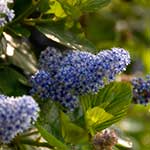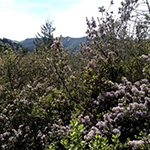Red Root
Ceanothus spp.
Rhamnaceae

the plant: A California native shrub with over thirty different species and hybrids found locally, Ceanothus is found mostly in the North American west, but also in the mid-west and northeast. The most widely used Ceonothus in commerce is the east coast Ceonothus americanus, but western US herbalists have found that the local species work just as well.
It is a stunning little shrub, between two and ten feet in width and two to four feet hight with oval leaves and sometimes spiny branches, and clusters of tiny aromatic flowers. The flowers range from white to blue to purple and bloom from spring to fall depending on species, rain and heat. The root bark is red or wine-colored on the outside, and pinkish in the middle.
The leaves taste a bit like tea and were brewed as a replacement during the Revolutionary War.
 parts used: root, leaf (less common)
parts used: root, leaf (less common)
medicinal actions: astringent, alterative, lymphatic, anti-inflammatory
preparation: fresh root tincture, cold infusion, decoction, hot infusion (leaf)
contraindications: Can be irritating in higher doses; use carefully if undergoing medical treatment for any disease.
indications: Red Root is an aromatic bitter and slightly warming herb that yields a deep red tincture and is associated with the blood. It helps move the blood and lymph more freely throughout their channels, helping with swollen lymph nodes or the ill-effects of sluggish, fatty blood. The ability of Red Root to stimulate and support this fluid movement makes it potentially useful in treating hemorrhoids, varicose veins, broken capillaries, breast/ovarian/testicular cysts, heavy menstruation or swollen spleen due to viral infections. Many herbalists find that it is used best in formula with other supporting herbs. Because of its astringency it has also been used by Native Americans and early American doctors to stop bleeding.
Beyond the western lymphatic spleen, Red Root has a special connection with the Spleen in Traditional Chinese Medicine - the organ that moves the fluids around the body and plays an essential role in digestive metabolism by drawing the nourishment from digesting food into the body. Thus Red Root can address stagnant, irritated damp digestion that comes with cold, dry symptoms. Matthew Wood talks about the Greek connection of spleen with 'melancholia' - similar to TCM spleen ideas that excessive thought and introspection can bring about a 'Spleen' imbalance marked by sluggishness of direction, purpose and creative flow. He recommends smaller more energetic doses for this.
note: This information is not a replacement for a trained herbalist. Please consult your medical professional before treating yourself or others with this or any other herbal remedy.